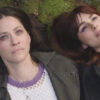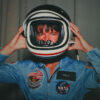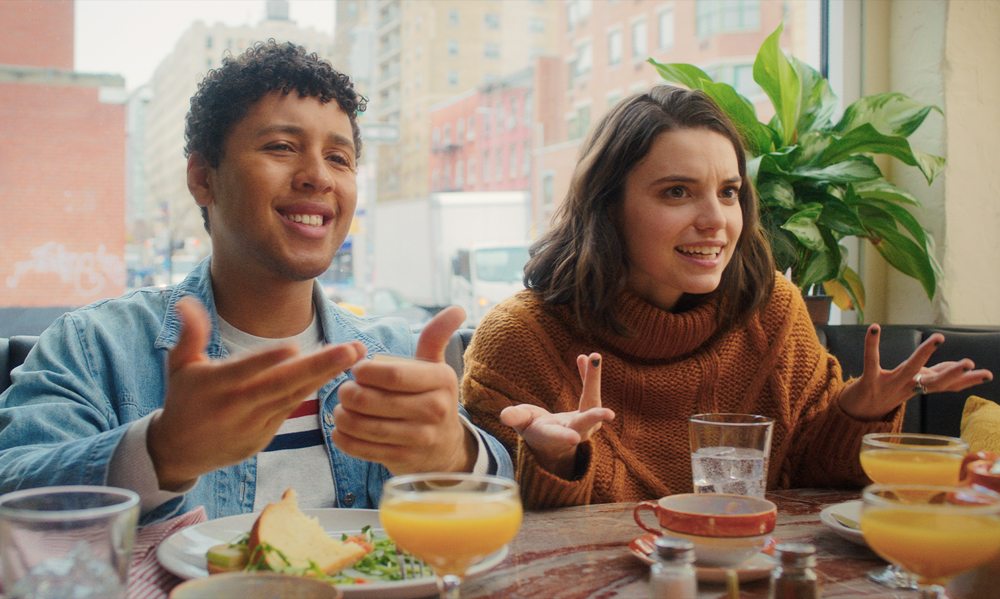Even if his debut feature “Dating and New York” wasn’t evidence enough, Jonah Feingold knows a thing or two about courtship, realizing that to get the perfect pair together for the charming romantic comedy, he’d have to make some grand gestures of his own in getting the right actors to place the parts. His male lead, Jaboukie Young-White, was sold after a dinner of tacos and margaritas, initiated by a letter Feingold had written expressing his admiration for his work in the Netflix film “Someone Great,” but for Francesca Reale, an actress potentially as difficult to pin down due to a busy schedule as her on-screen noncommittal alter ego Wendy would be, the writer/director knew he had to pull off something special, so when only a FaceTime could be arranged for a meeting with Reale in Los Angeles and Feingold in New York, he made an offer she couldn’t refuse.
“I was in Central Park and I was like, ‘Look, Fran, you want come to New York and make a movie in the fall?’ recalled Feingold, already composing one of the most important shots in the film when seeing the skyline behind him convinced Reale to sign on. “It was like Nick Fury at the end of ‘The Avengers,’ saying, “You want to join the team?” That’s what I think the way that directors should feel like when they’re casting their movies.”
Although he’s working in a decidedly different genre, Feingold does appear to have some superpowers in making “Dating and New York,” imagining a city made for romance that is at odds with two millennials not interested in a committed relationship. Taking clear inspiration at first from “When Harry Met Sally,” setting its sights on friends with benefits Wendy and Milo (Young-White) who go so far as to draw up a contract that has detailed the terms of their relationship (“PDA is a no-no for us”), the film’s originality takes hold as the two begin to find themselves in a Doris Day/Rock Hudson version of Manhattan where the particularly fetching look of Tompkins Square Park in the fall seems to be an extension of their true feelings for one another, though the cell phones they use can give the impression of intimacy that hasn’t yet materialized and offer limitless distractions from ever having deep, heartfelt conversations, stunting their growth as a potential couple and only needing to see friends Jessie (Catherine Cohen) and Hank (Brian Muller) start to get serious to see where they’re dropping the ball.
“Dating and New York” may not have all the polish of a studio comedy – a good thing when the humor has edge too, it is every bit as enchanting with wry narration from Milo’s doorman, played with good spirit by Jerry Ferrara, warm cinematography by Maria Rusche and an equal desire to explore the city as much as the heart as Milo and Wendy that whether in the place they live or who they live with, putting up with all the small frustrations is part of what creates passion. As Feingold explains, this was no small endeavor and with much of the crew from last year’s sensation “Shiva Baby” behind it from producers Katie Schiller and Kieran Altmann to Rusche and editor Hanna Park, the director was able to hit the ground running in his delightful feature debut and with the film arriving in theaters and on VOD following a premiere earlier this year at the Tribeca Film Festival, he spoke about how there was just as much magic in making “Dating and New York” as there was caught on camera and how he had prepared himself well for everything to fall into place so beautifully.
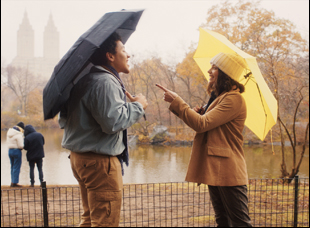
You look at the short to feature path and these filmmakers like Damien Chazelle, who makes “Whiplash, and I always wondered myself, “Oh, I didn’t do that exactly with this movie, but at the same time, there have been many short films that have explored modern dating and the use of technology in romance and in a romcom space,” all not necessarily the same characters, but all in the same theme and vibe. So the truth of it is I grew up loving romantic comedies, Nora Ephron and Nancy Meyers, and it was always a genre that I really wanted to explore, but when you go to film school, not many people come into film school saying, “I want to go make romantic comedies.” It’s typically, “I want to go make a great thriller.” Or, “I want to go be like David Fincher.”
I didn’t know the entry point for a long time. I [thought], “Well, what is there new and what can do with the romcom genre to pay homage, but also to be different?” When I was working at Buzzfeed, I just started to finally notice that there’s this new vernacular that exists with texting and with Instagram that I didn’t see in romcoms, and I was like, “Ah, that’s it.” And it was specifically with the short film, “Maybe Josh,” where I said to myself, “Okay, this could be something that explores a tale as old as time — people trying to be friends with benefits, but also incorporating elements of modern “I miss you” texts on screen and doing what the movie “Searching” did so wonderfully, which was adding emotion to these very digital moments. That’s exactly what I attempted to do for many years and then it was time to come make the feature and I’m very proud with the way that it integrated into something that feels hopefully both classic yet very modern.
The online elements are typically something you have to work on in post-production, but it looks like you were keeping the actors engaged in the process. Was that a tricky part of the process to figure out?
The text messages were in the script, but the way that came into practical directing was me going over to Jaboukie and saying, “Hey, by the way, in the scene, prior to this, you sent her a text that she didn’t respond to.” And it was as simple as that. The ice cream scene, there’s a little bit of animosity there, and it was also the first day [Jaboukie and Francesca] worked together, which was perfect because they didn’t know each other yet. And fun fact, the “I miss you” text thing was actually Wendy getting broken up with by her fiance — there was a whole subplot where she was engaged and it was a flashback, but in the edit, we [realized] it’s something that the audience would enjoy, but it makes more sense [to leave it out], so we just reworked it.
That was the beauty of it. There was always a text, because she’s only looking at the phone, but it was originally a text from her fiance breaking up with her, and the meet-cute stuff in the beginning is actually the hardest thing to do because you have to create the rules of the dating app. You have to look at it from a programmer’s perspective, then you have to come up with the copy for the character and you need to figure out how that’s going to exist in the context of the narrative and how are you expressing that to the audience in a fairytale-type tone. In the script, I think it says, “We open to the digital world of meet-cute and these characters swipe right on each other” – two lines of prose. But what that looks like in the movie is three minutes and a ton of drafts and VFX work of timing that.
One of your earlier shorts was “405 Love Story: Dating in Los Angeles” – was New York always in mind for this?
Yes, I was born and raised in New York, and I lived in L.A. for about seven years because we were told as filmmakers that to be a Hollywood director that perhaps you need to live in L.A. and I think there’s a lot of truth to that, but I also lived in L.A. for seven years and I never got a movie made and it was only after moving to New York that all the pieces fell together. That’s not to say that all those key relationships that were built in Los Angeles were not imperative to the process, but I had always missed being here. It’s my home, so I’d always wanted to come home and be able to make a movie here and you can point the camera wherever you want and it’s just such a beautiful city. New York has such a beautiful happenstance and serendipity to it, that you could have these magical moments. You can have the subway signs that are speaking to and you can have the therapy session on the street. And that was exciting to explore, in terms of using magical realism in a way that felt magic, but also, “Wait, this could happen to me.”
Did you always imagine this many locations?
Always what I had in mind? Yes. But do I advise anyone going to make an indie movie in New York when the general rule is you should never have more locations than you have shooting days? We had 22 locations and we shot for 15 days, so that is something that I look back on that’s a lesson in terms of indie filmmaking. Yes, you have your script, your dream story, but then when you just start to line out your day out of days and your budget, and you start to work with your line producer, your production team and your cinematographer, you start to say, “There’s a lot we can do to make our life a thousand times easier by simply moving these locations around and don’t spend all day in a diner. Spend half a day in a diner and get what you need and get out.” So I feel so grateful that our my cinematographer, my line producer, my AD, my producer and our incredible team was able to make us pull this thing off. The next movie that we make in New York, I think we’re going to keep the location count a little bit lower, just to make everyone’s life easier.
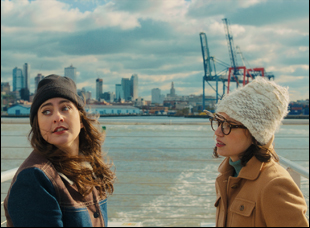
It was a dream come true. Honestly, it made the movie happen. It was almost like building “The Avengers.” I convinced my friend Joaquin [Acrich] to quit his job as an assistant and move to New York and make his first feature film, and then it was a matter of, “Okay, who’s going to line produce this? Who’s going to co-produce it? Who’s going to [assistant direct] it?” Maria [Rusche] was the first cinematographer that I wanted for the film and we sat down and instantly bonded over “Jaws” and “National Treasure” and classic, commercial romantic comedies and then she was like, “I just worked with these two amazing producers Katie [Schiller] and Kieran [Altmann]. We just made a movie around a similar budget range in August. They’d be perfect for this.”
Then I sat down with Katie and Kieran and they blew me away. They said, “Look, we have the team, we just did it. We can come in and we can do this movie with you.” They all went to NYU together and it was like meeting your distant family members for the first time because they were already so close. Then it was a matter of us getting into our rhythm together, but I think we really found something special and I loved it. I loved that everyone knew each other. They had a shorthand, they were all friends and I didn’t have to necessarily worry about them all becoming close, it was there and I think had they not come in like that, our movie would have never been made, or at least certainly not at the level that it was made at.
When you’re seeing everyone’s energy together for the first time, does this start going in directions you hadn’t expected?
Cat and Brian were a dream come true. Their chemistry was insane because, by the way, they were just starting to date in real life, and I’m like, “This is perfect.” They were actually at the same place in their relationship in real life as they were supposed to be in the movie when we were shooting some of those scenes, so it was very easy. And for Jaboukie and Francesca, we actually didn’t have a chemistry read. That’s nerve-wracking for a director going into a romcom, but I put them in a PowerPoint together. I found some of their scenes on the internet and I just went into Adobe Premiere and I just cut scenes together, and I was like, “Could these two exist?” And that was enough evidence to trust that instinct, but of course, they got together perfectly, [and] the ice cream scene is the first day they met and it’s nice because they don’t really know each other yet, off screen and on screen and that’s in line with that scene’s arc as well and as they spend more time together, they develop a friendship offscreen and then that starts to translate on-screen, so we just got so lucky.
What was it like to shoot in Washington Square Park?
That was the hardest day for several reasons. First off, it was about 20 degrees. And then you have a 16’ dolly track that is a slow push in shot to Francesca’s character, Wendy, as she sits down and starts crying and you are doing this in the middle of Washington Square Park, and whether people recognize Francesca or they just see a movie set, there’s a crowd. And I want to shout out Roger Mancusi, our production coordinator who is 6’6” and looks like a football quarterback, and Katie Schiller, our AD, who is not 6’6, was like, “Roger, I need you to play defense here.” So Roger’s blocking off all these people and meanwhile, Francesca’s approaching a very sensitive scene and it’s not easy for an actor to cry, let alone perform in front of an audience, so here I am trying to figure out how to work with her.
It’s cold and we’re losing light and at 4 pm, it’s lights out, so it was just chaos. I will say the one cool fact about that scene that really helped me channel the magic of this whole crazy world of moviemaking is that I’ve sort of gone on the record and said that my favorite movie of all time is “Hook,” and there’s a character named Rufio, the leader of the lost boys when Peter Pan goes away played by an actor named Dante Basco. Dante has become a friend of mine over the past few years, and we’re shooting this scene and I get a call from Dante being like, “Hey, man, I’m in New York, I’m just walking around the West Village. Where are you?” And I’m like, “Dante, I’m actually literally directing a scene, but if you want to come visit set, I’m in Washington Square Park.” So Dante shows up to set. He’s in video village with me and he’s got his hands on my shoulder. He’s like, “Dude, you got this. This is great, man. Look at you with a 16’ foot track,” and here I am having Rufio, the leader of the Lost Boys encouraging me to just see the scene through. It was just very magical. So it was easily the hardest day of production, but we got the shot and it’s a great memory.
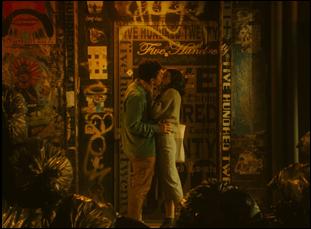
It was an equally magical experience. I’m obsessed with film scores — that’s all I listen to — and I’ve been so lucky to have been partnered with Grant Fonda, our composer, who did one of my short films and who I went to USC with. We both love John Williams and Jerry Goldsmith and we’ve been talking about the themes for this film since before we went even into production, so we would have days on set where I could put an earbud in Francesca and Jaboukie’s ear and say, “Hey, this is your theme. This is what’s going to sound like,” and it was just piano sketches.
When it finally came time to score it, obviously COVID had hit and we were doing three-hour-a-day sessions [where] he’s got a piano and we’re looking at scenes, and we’re spotting, going through where the music is going to exist and then he goes off, writes his cues, puts them into digital and we review them together. When our scoring day came, it’s typically a very magical day where you and your composer sit in the booth and you see this whole thing just happen, but unfortunately, I wasn’t able to fly to L.A. for that session, so what I did was, I just moved into an apartment and I set up the kitchen to put a big TV screen that we have [in it] and I HDMI’d it. I basically built my own little control room where I could just sit there with the headset, and we used special software so that I was actually getting the live feed from the musicians into my headset, so it was the live mics in that room. I would just sit there and I had [Grant] in the corner, so I could see his reaction, and then I had a camera on the actual film that was playing in the reel and then I had a camera on the musicians. And Scott Frankfurt Studios, the place that we did it, was amazing. I was there at 9 AM and I had my snacks and my coffee and I sat there at the computer and watched this whole score come together. We had a live choir, a live jazz band, but it was still equally as magical and fulfilling.
“Dating and New York” opens on September 10th at the IFC Center in New York.

